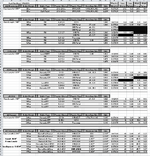Organization is a highly developed form of laziness." - Unknown
Some things I have found handy I'd like to share:
1. I keep an inventory of my reloading components in a MS Works spreadsheet file, kept updated. Some of my reasoning.
It is good (essential) to know what you have in detail. Before I started keeping a detailed inventory, when a good buy in components came up I would have to wonder "How much of that do I already have?". That would lead to an expedition into the gun room and opening up various ammo cans and storage boxes to check. Sometimes I would later find I had purchased stuff I already had ample supply of (oh yeah like that's NEVER happened to you!).
With an inventory spreadsheet I can pull it up and check in LESS THAN A MINUTE.
I have record columns for component mfgr, description, quantity, cost and misc remarks. AND LOCATION.
2. I keep a similar spreadsheet of my ammunition.
I have record columns for component mfgr, description, quantity, bullet weight, bullet shape, and misc remarks including cost, date of mfgr, date and source acquired. AND LOCATION.
3. On my spreadsheets I note WHERE a particular component or caliber is stored. What shelf, what number ammo can, etc. This alone has saved me an INCREDIBLE BUNCH of time and effort.
4. On my reloading components spreadsheet I have live calculation fields for how many rounds I can load with the components on hand, indicating my preferred load in each caliber.
Just remember 7000 grains to a pound and the rest is pretty simple.
(Pound of powder x 7000) divided by grains per round = number of rounds you can load from a pound. Easy-peasy.
Bullets, brass and primers are simple as they are one unit each (although you can reuse most brass).
THIS IS A BIGGIE. By devoting a single line to a favorite load I can calculate how much powder is needed to load all the bullets I have for that load, and confirming that I have (a) Enough primers for it and (b) Enough brass for it.
There is a remarkable peace of mind in knowing that if tomorrow Cankles gets elected, I can sit down with my reloading gear, and maybe a few friends, and load EVERY SINGLE COMPONENT into finished ammo with NOT A THING LEFT OVER or shortage. Everything comes out even.
Doing this will also let you know what to buy next to balance out your inventory.
For instance if you have 10k bullets and brass, sufficient powder but only 6K primers, (OOPS!) this spreadsheet will let you see this immediately.
And finally, spreadsheets aren't hard to learn. If you haven't used one before find a friend to Rabbi you through your first few starts. After that it's pretty simple.
Doing this has paid HUGE dividends for me in terms of saving money, efficiency, ease of use and peace of mind over 25 years.
Some things I have found handy I'd like to share:
1. I keep an inventory of my reloading components in a MS Works spreadsheet file, kept updated. Some of my reasoning.
It is good (essential) to know what you have in detail. Before I started keeping a detailed inventory, when a good buy in components came up I would have to wonder "How much of that do I already have?". That would lead to an expedition into the gun room and opening up various ammo cans and storage boxes to check. Sometimes I would later find I had purchased stuff I already had ample supply of (oh yeah like that's NEVER happened to you!).
With an inventory spreadsheet I can pull it up and check in LESS THAN A MINUTE.
I have record columns for component mfgr, description, quantity, cost and misc remarks. AND LOCATION.
2. I keep a similar spreadsheet of my ammunition.
I have record columns for component mfgr, description, quantity, bullet weight, bullet shape, and misc remarks including cost, date of mfgr, date and source acquired. AND LOCATION.
3. On my spreadsheets I note WHERE a particular component or caliber is stored. What shelf, what number ammo can, etc. This alone has saved me an INCREDIBLE BUNCH of time and effort.
4. On my reloading components spreadsheet I have live calculation fields for how many rounds I can load with the components on hand, indicating my preferred load in each caliber.
Just remember 7000 grains to a pound and the rest is pretty simple.
(Pound of powder x 7000) divided by grains per round = number of rounds you can load from a pound. Easy-peasy.
Bullets, brass and primers are simple as they are one unit each (although you can reuse most brass).
THIS IS A BIGGIE. By devoting a single line to a favorite load I can calculate how much powder is needed to load all the bullets I have for that load, and confirming that I have (a) Enough primers for it and (b) Enough brass for it.
There is a remarkable peace of mind in knowing that if tomorrow Cankles gets elected, I can sit down with my reloading gear, and maybe a few friends, and load EVERY SINGLE COMPONENT into finished ammo with NOT A THING LEFT OVER or shortage. Everything comes out even.
Doing this will also let you know what to buy next to balance out your inventory.
For instance if you have 10k bullets and brass, sufficient powder but only 6K primers, (OOPS!) this spreadsheet will let you see this immediately.
And finally, spreadsheets aren't hard to learn. If you haven't used one before find a friend to Rabbi you through your first few starts. After that it's pretty simple.
Doing this has paid HUGE dividends for me in terms of saving money, efficiency, ease of use and peace of mind over 25 years.












